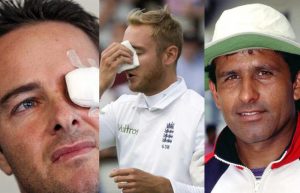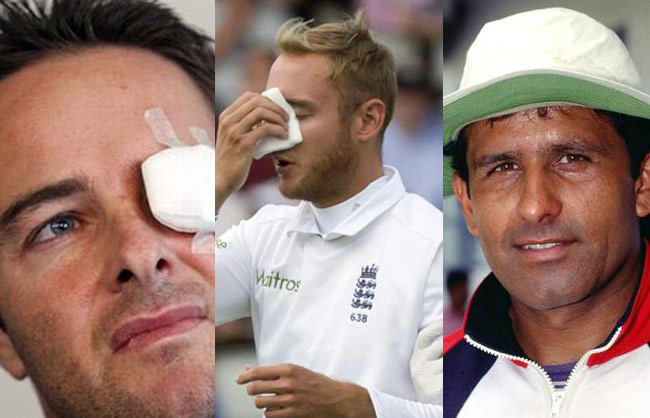
Concussion in sport
March 12, 2017
MUSCLE WEAKNESS vs MUSCLE INHIBITION: the difference!
March 20, 2017 Cricket has been played since 1877 and originated in south-east England. It became England’s national sport in the 18th century and has developed globally in the 19th and 20th centuries. international matches have been played since 1844 and Test cricket began in 1877.
Cricket has been played since 1877 and originated in south-east England. It became England’s national sport in the 18th century and has developed globally in the 19th and 20th centuries. international matches have been played since 1844 and Test cricket began in 1877.
The most serious and fatal injury occurs when you been bowled at or field and get the impact of the fast and hard cricket ball on your head or face or chest. The most serious and fatal injuries that occurred during international matches were:
1. The Australian batsman, Phil Hughes died in November 2014 after he was struck by a cricket ball on the bottom side of his head at an exposed area below his helmet. Although this was purely a freakiest and unfortunate accident, the death of a 25-year-old international cricketer sent shock waves through the world of cricket. This incident raised the awareness of proper protective helmets that cover the head in all areas. (Article on Phil Hughes death).
2. Raman Lamba, an Indian batsman died after getting hit by a ball on the head while fielding at silly mid-on in a Bangladesh cricket league match in February 1998.
He underwent a surgery and the blood clot was removed, but after three days Lamba succumbed to his injuries. He was 38 at the time of his death.
3. Abdul Aziz, a 17-year-old Abdul Aziz of Pakistan got hit directly on the chest by a delivery and fell unconscious. He passed away on the way to the hospital.
Although very uncommon, these injuries took the cricket world by shock.
More common cricket injuries can be grouped according to the position of the player: batsman, bowler and fielder.
Batsmen common injuries:
Less serious head injuries caused by ball impact are concussion, head/facial laceration, whiplash injury and superficial bruising/swelling.
Other common injuries that may occur during batting
1. Dehydration due to high humidity and batting for long hours
2. Muscle cramps
3. Hamstring of groin muscle tear
4. Lower back spasm and disc injuries
5. Ankle sprain when turning during running
Common injuries that may occur during bowling
1. Lower back muscle injury (spasm/strain)
2. Stress fractures of the lumbar spine ( bone injury due to repetitive train)
3. Spondylolisthesis and spondylolysis
4. Side strain ( intercostal muscle injury)
5. Shoulder impingement or rotator cuff injury
6. Achilles tendinitis
7. Shoulder dislocation
8. Golfers elbow or tennis elbow
9. Also dehydration, muscle cramps, hamstring or groin muscle injury and ankle sprain
Common injuries that may occur during fielding:
1. Direct impact of ball on your body causing fracture, contusion, or hematoma
2. When you need to catch or stop a ball your commonly can suffer from laceration of finger (web laceration) or dislocation of finger
3. Wicketkeepers are at risk of eye trauma or laceration of cornea when bails or ball directly impact on face
4. Nose fracture (* as above)
5. Fielders may also have an increased risk of hamstring tears while running or ankle sprain or shoulder dislocation during a fall.
Although there is little collision between players, knee injuries can also occur during running and turn:
1. Medial knee ligament strain and tears
2. Knee ACL tear
3. Patella dislocation
4. Menisci injury during twisting and turning or during a jump or fall
All above injuries are the more common injuries or serious injuries but all types of trauma or overuse injuries are possible.
Nowadays most teams have a physiotherapist with them and all matches have a match or venue doctor. All top international teams have full-time physio, trainers and doctors as part of their staff. The medical staff are there to manage prevention of above injuries and rehabilitation should any of these injuries occur.
Prevention of injuries:
1. Protective gear and proper equipment are essential as the impact of the hard cricket ball on your body can cause severe trauma
2. Good physical preparation and conditioning to make sure your body is strong and fit to endure the physical challenges of a cricket season
3. Pre-season musculoskeletal assessment to address any weaknesses or overuse structure on your body
3. Medical assessment to assess general health, hydration status, nutrition status, use of supplements, good vision and good recovery.
4. Engage with your fitness coach to ensure your fitness levels are maintained right through the season and your recovery are optimal.
5. Report any fatigue muscle soreness, stiffness, pain, swelling or unwell feeling to your medical team for further assessment.
Enjoy the game!
Dr. Arthur


